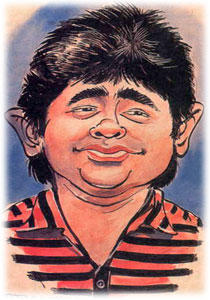MAHESH BHATT
| From silent sufferers to go-getters, heroines have come a long way. But do they portray the 21st century woman, wonders a leading filmmaker. |
The much touted revolution in cinema seems to be only on the surface. Deep down the industry still remains shackled to the old myths on the male-female equation.

“Has the portrayal of the Indian woman changed over the years in our movies? Are they still shackled to the posts of cultural myths or have they broken free to fly where they will, in keeping with the myths that the 21st century has created in our so-called rapidly changing Indian cinema?” I asked Shabana Azmi, the icon who brought dignity and grace to the Indian woman both onscreen and off.
As the singers rehearsed to deliver their finales for the last episode of a reality show we were both judging, Shabana turned her gaze inwards. As she pondered on this, we heard the tantalising sound of a woman’s voice singing the raunchy beedi jalaile jigar se piya…, forming the background music for this serious question. It was almost as if the answer had been provided there and then on a platter.
EvolutionBut I was in for a surprise. With great patience, akin to the demeanour of a schoolteacher, she began to talk about the evolution of the heroine on the Indian screen. It is well nigh impossible to reproduce in this piece the complete conversation. However, it went something like this: In the 1960s, towards the end of the black and white era when the age of colour was being ushered in, the Indian heroine epitomised by Meena Kumari was a silent, suffering, tongue-tied entity who believed she was to be seen and not heard; so deep was her feeling of unworthiness. “Main Chup Rahoongi”, a blockbuster from South India, summed up what the men in India wanted their women to be.
The 1970s, which belonged to Hema Malini at one end and Zeenat Aman at the other, reflected the two sides of the Indian woman — one traditional and the other western — but still a part of a man’s world fulfilling his needs for romance, sexual gratification and procreation. The movies of the 1970s were so simple. It began and ended with whether the man would marry her or not. They had no connect with real life, yet they were so thoroughly entertaining, with their goody-goody heroines yearning for the hero’s glance in the richly wooded mountains of Kashmir.
The 1980s saw a change in the way the Indian woman was viewed, which was reflected in parallel cinema but not in the mainstream. “Arth”, with which I shot into the limelight, was undoubtedly a watermark. Films can easily be divided pre- and post-“Arth”, as it turned the tide altogether. In this film, the woman, after having rejected her philandering husband and being wooed by a lover, opts to walk away from both men in search of a career.
The 1990s swung in another direction yet again. Songs like Sarkai lo khatia showed the girl having a raunchy good time, totally unapologetic about her sexuality. Although it was still about sex and romance, this time the woman was an equal partner and not a giggly, coy thing who could not even think about sex. This was a quantum leap for cinema vis-À-vis women. This pleasure-seeking, pelvis-thrusting woman was the subject of great criticism from the elite and cultural purists. Earlier the good heroine catered to our pious aspirations and the wicked vamp stoked our carnal fires; but now the wife and the whore were mixed up together in a heady cocktail and this whetted the male appetite for more.
Globalisation
By the New Millennium, as globalisation became a reality, Indian homes from Mumbai to Raipur were flooded with erotic images of semi-clad women and bold sexual content. The satellite invasion had arrived. Images from MTV and Star World altered the moral references of the indigenous Indian population. So, in the winter of 2002, when Pooja Bhatt released her erotic thriller “Jism”, it ran to packed houses in the elite suburbs of New Delhi. The surprise here was that the hall was filled with rich women in silken shawls as well as the usual male suspects. The woman both on screen and off was changing.
No wonder then that Mallika Sherawat, a girl from small town India, became a big hit with my film “Murder”, in which she played an unfulfilled wife who crosses the Laxman rekha to gratify her carnal desires. But the so-called revolution in the portrayal of the Indian woman was only skin deep. To be honest, Bollywood, which manufactures illusions rather than capturing reality, has failed to project the 21st century woman. Except of course for a few brave films like “Page 3”, “Life in a Metro”, “Dor”, “Parineeta”, “Chandini Bar”, and “Dus Kahaniyan”. The much touted revolution in cinema seems to be only on the surface. Deep down the industry still remains shackled to the old myths on the male-female equation.
One of the most difficult aspects of adapting to rapid change — particularly when it is accompanied by complex technology and multiplying data sources — is one’s ability to give up an old construct and develop a new one based on current realities. Accepting a new version of reality and telling a new story requires cultural intelligence. But for that, we need the ability to observe, learn and understand not only our own culture but the culture of the others as well.
In a globalised world, where local markets are being destroyed by international brands, Bollywood had better wake up or its chances of being heard in the cacophony of the current market place are slim to none.

No comments:
Post a Comment